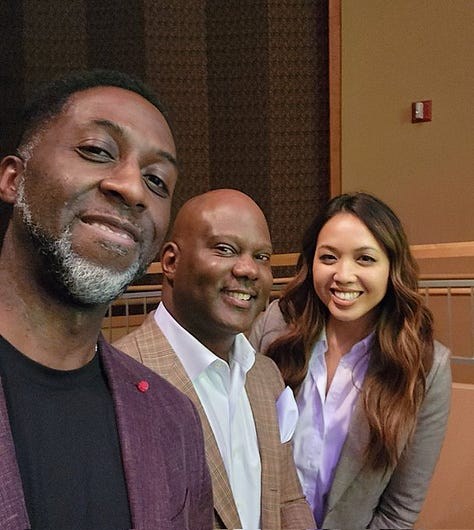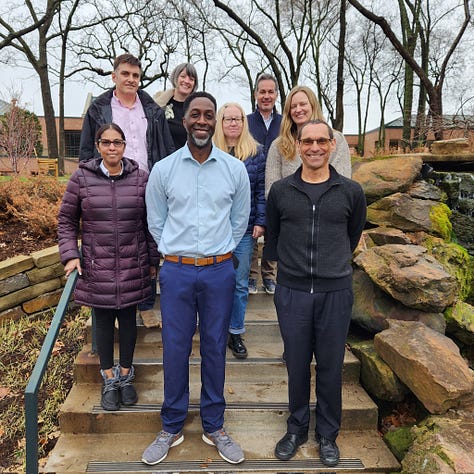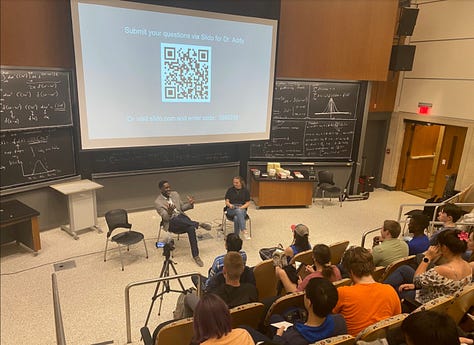Am I speaking to society with breadth, depth or confusion?
Reflecting on the pros and cons of not being able to fit into one box
My Journey
With everything happening in society and the reach of social media, everyone seems to share their opinion about everything. It’s good to see many people using their spheres of influence and platforms to promote mental health, reduce stigma and speak out against social injustices. But as a society, have we veered too far toward accepting opinions and preferences as facts and expertise?
I discussed this topic with Eddie Glaude Jr., distinguished professor, author and political commentator, and AD Thomason, professor, author, speaker and award-winning filmmaker, in a previous Addy Hour conversation.
As I’ve had the opportunity to speak on many topics, I’ve been reflecting on how I show up in certain spaces and frame my comments. Whether during a live radio interview, in print, in a lecture, a keynote or a panel discussion, or in one-on-one conversations and small group settings, I wonder if my commentary on a wider breadth of topics is coming at the expense of depth.
Admittedly, my wide-ranging efforts create confusion at times. During a recent speaking event, I acknowledged this confusion, and unsurprisingly, participants confirmed that they didn’t understand my primary role or focus area. That’s probably because I don’t have one!
My various roles don’t fit in a box. I’m a university professor, neuroscientist, lab director, mentor, research advisor, educator and role model. I’m also a diversity, equity and inclusion (DEI) leader at my institution and in several scientific societies. I’m a mental health advocate, a frequent speaker, a podcast host, and a person of faith who delivers occasional sermons. More recently, I’ve also engaged on many social media platforms, including Twitter, Instagram, YouTube, LinkedIn and TikTok.
On one hand, the opportunities are boundless. In the past few months, I’ve enjoyed interacting with several different communities — parents, high school students and college students from Southern California to State College, Pennsylvania to Upstate New York; researchers at a brain imaging institute in Tulsa, Oklahoma; and students and community members in Boston.



Over the years I’ve been blessed to speak to a range of audiences, including K-12 schools, colleges and universities, scientific conferences, community groups, churches, boards of education, governmental organizations, and Fortune 500 companies. This has provided me with incredible opportunities to learn from many different people and to share in their joys and challenges.
With my various interests and investment areas, I sometimes find it difficult to decide on a specific topic for some events. When doubt starts to creep in, I wonder whether I’m truly equipped to speak with depth or clarity on so many topics. Thankfully, as you all engage with me through the newsletter, podcast and in-person events, you continue to help me reset.
As I share stories, experiences and lessons learned with you, I’m reminded that I developed my “breadth” over several years. At a “Mental Health, Neuroscience, Hope and Healing” fireside chat with MIT students this month, I realized that I could only answer the wide ranging, insightful questions with clarity because of my unique combination of research, experiences, writings, interactions and mentoring, along with the deep investment and support I’ve received over many years.
We’ll see how my thinking continues to develop as I learn new skills to communicate with more breadth, and hopefully effectiveness! I’m so grateful to work alongside so many talented teams in these efforts. I’m also thankful for those who’ve invested in me over the years and helped me develop these interests. Finally, thanks to all of you for joining me on this journey!
I’d love to hear about how these efforts have impacted you! What podcast topics have you most appreciated? Which newsletter entries have you enjoyed? What else would you like to see added or even removed? Let me know in the comments.
Wellness Tips
We’re navigating a lot as a society—both joyous occasions and ongoing challenges. Many of you mentioned that the challenge of increased mass shootings weighs heavily on you right now. This includes mass shootings covered in national media and the countless gun violence tragedies that don’t reach a national audience, as author and activist Jemar Tisby recently highlighted in Louisville, KY.
We tend to think about societal challenges through our own perspectives and experiences, even as we empathize with others’. This happened to me when I learned about Ralph Yarl, a Black teenager who was shot by an older white man after ringing the wrong doorbell when he was just trying to pick up his siblings. I couldn’t help but think of when I rang the wrong doorbell in a predominantly white neighborhood as a Black teenager, trying to find a friend’s house. It was early evening, but dark, and I wore a baseball cap like so many teens did. I’m grateful that my own situation did not end in tragedy.
So, how do we navigate these ongoing challenges? If it’s a situation that doesn’t affect us personally, do we instinctively tune it out and go about “business as usual?” Or do these continuous tragedies weigh on us, negatively impacting our daily lives? Many of us move between both these reactions. As a Black, Kansas City mother of one of Ralph’s classmates powerfully wrote, there are numerous layers and challenges to raising Black children in the U.S — something I certainly relate to.
For this week’s mental wellness tips, I share two insights from former podcast guests on managing your mental health amid disheartening news cycles. The first is from my 2021 Addy Hour conversation with Doug Middleton, former NFL player and president and founder of the Dream the Impossible foundation, and Dr. Alfiee Breland-Noble, clinical psychologist, mental health expert and founder of the AAKOMA project. Her advice is simple:
“Curate your news.”
Dr. Alfiee reminds us that that we don’t need to consume negative news 24/7. You can create time and space to check in, and boundaries to decide how much—or what images—to take in or out. This doesn’t mean ignoring the realities around us; rather, you don’t need to feel obliged to constantly digest and process so many tragedies. Doug also shared poignantly about this strategy, in our podcast conversation.
The second tip is from recent podcast guest, Dr. Thema Bryant. As she shared on Addy Hour:
We can hold the tragedy and hope together.
Dr. Thema uses this practice in her daily life. We should certainly make room to commiserate, grieve and lament tragedy. Yet, we can also feel encouraged knowing that there are people who are deeply invested in addressing these societal issues, supporting those who are negatively affected, and providing tools to navigate these challenges. While this doesn’t negate the work that needs to be done to change policy and invest in lives and communities, it does give us ways to navigate in our own lives.
A Look Ahead
Here’s a sneak peek at our upcoming episode with Rev. Dr. Otis Moss III on justice, activism, and the church.
Dr. Moss is the pastor Trinity United Church of Christ, and an author and activist with a personal and family legacy of leadership in the church and in the fight for human rights, civil rights, social justice. His pastoral and community efforts have been strongly shaped by Black history, by his father Dr. Otis Moss, Jr, and by his father’s former colleague, Dr. Martin Luther King, Jr.
As described in his bio, “Dr. Moss has practiced and preached a Black theology that unapologetically calls attention to the problems of mass incarceration, environmental justice, and economic inequality.”
You won’t want to miss this rich conversation.




